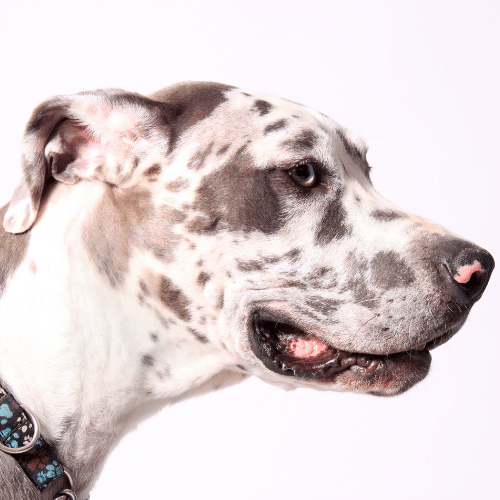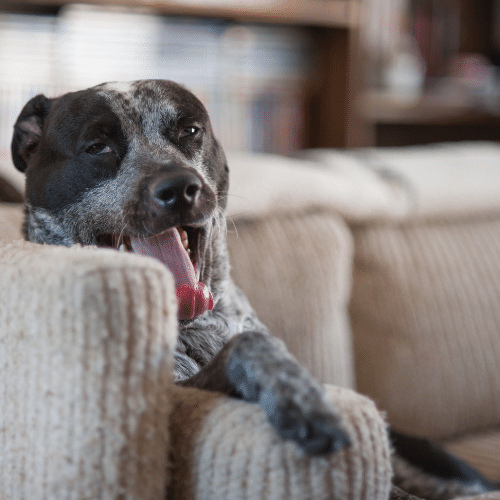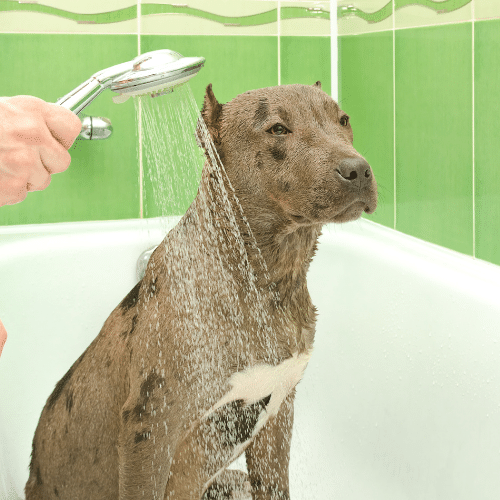Merle Pitbull
August 15, 2021 2021-08-15 17:39One quick Google search will reveal many breeders selling Merle Pitbulls, typically for very high prices. One such breeder was selling merle puppies for $35,000. And, who can blame them! The unique black and white coloration of this breed is beautiful to many buyers. Its rarity also allows these puppies to be sold for extremely high amounts.
However, the major problem with merle Pitbulls is that they simply don’t exist – technically. The breed standards for the American Pit Bull Terrier list the merle coat as an automatic disqualification for any dog. The UKC simply doesn’t recognize merle puppies as actual Pitbulls.
This is also true for many descended breeds of the American Pit Bull Terrier, including the American Bully. All lines of Pitbull are not recognized as having the merle coat, so there isn’t some rare, unique Pitbull bloodline out there that all of these puppies are coming from.
So, where are these puppies coming from then?
Once upon a time, the merle gene did exist in Pitbulls. However, it is associated with some health problems. Therefore, these dogs were not bred, and the gene wasn’t passed on. Today, these gene is extremely rare if not impossible to find. Dogs simply don’t carry it anymore. Therefore, these dogs are either very expensive or the result of mixing the Pitbull with another breed.
Table of Contents

Appearance
The Pitbull is more appropriately referred to as the American Pit Bull Terrier. While the term pitbull is sometimes used to refer to other dogs, this is incorrect and a result of misinformation.
These dogs are typically medium-sized. Males are typically somewhat larger than females, weighing at 35 to 60 pounds. Females weigh significantly less at 30 to 50 pounds. Practically any color is accepted for this breed except merle, which is why this coloration is so controversial. Red, black, and buckskin are the most common.
Their coat is short and smooth. It only features a single layer, which does help reduce some of their grooming needs. However, this fact also means that they are less able to deal with colder temperatures. They have a well-defined muscle structure. Beyond this, their features can vary somewhat. They can have round to almond-shaped eyes. Their ears are typically small or medium. While completely erect ears are the most common, having a slight bend at the tip isn’t unusual either.
Merle is a genetic pattern that features mottled patches of color. Beyond these patches of color, the dog has a solid or piebald coat. Usually, dogs with the merle pattern have odd-colored eyes. While merle does occur naturally in some breeds, it is not recognized as a color for Pitbulls.
This is mainly due to the health problems that come with this coloration. This coloration does exist in the Pitbull breed. However, the current policy of the ABDA is to avoid registering these dogs due to their prevalent health problems. Breeders have generally been breeding out this trait for some time, so it is rare in purebred dogs.
Some breeders mix Pitbulls with other merle breeds to reintroduce the merle gene. Some lucky breeders can locate this gene within the Pitbull population and encourage it through breeding. Either way, this isn’t recognized as an official coloration by any kennel club and is heavily discouraged.

History
The history of the Merle Pitbull is quite complicated. It is a very controversial issue with breeders on both sides of the argument attempting to change history to fit their own opinion. You’ll get many versions of the Merle Pitbull’s history, therefore.
This coloration has existed since practically the beginning of the breed, as far as anyone can tell. There are many different pictures and documents containing records of Merle Pitbulls as far back as 1922. Initially, in 1936, the breed standard stated that any color was permissible. This standard included merle colorations. Therefore, this coloration exists within the Pitbull breed and did so historically.
However, this coloration was never particularly common. Initially, this breed was mainly bred for a purpose. This purpose involved bloodsports, as well as hunting hogs and similar tasks. Because pitbulls were bred mainly for practical purposes, any weakness was eliminated. Merle coats are associated with health problems, so these dogs were typically sterilized or even culled.
As these sports were outlawed, aesthetic features began to be bred for. After all, the breed essentially turned into a companion animal overnight. These features include the rare merle coat. The rarity of this coloration allowed breeders to sell these dogs for more than the average Pitbull, so some breeders began breeding the merle coat almost exclusively for marketing purposes. They could simply make more money this way.
Some breeders were unable to find Pitbulls with natural merle genes. Therefore, they bred other breeds into their Pitbulls to reintroduce it.
However, there is quite a bit of controversy around this. The ADBA states that the reintroduction of the merle gene “can be detrimental to the soundness of the breed as a whole in the light of current research, which links the merle color pattern genetically with health defects.” For this reason, the ADBA does not register dogs with the merle coloration as of February 21, 2005. They state that this is for the betterment of the breed – not because the coloration can’t occur in Pitbulls.
On the other hand, the APBR allows for the registration of merle dogs. They argue that the color is naturally occurring in Pitbulls, and therefore dogs with the coloration should be recognized as actual Pitbulls.
Today, the legitimacy of Merle Pitbulls is largely up in the air.
Personality and temperament
The Pitbull is an amiable dog. They are extremely people-oriented and make excellent family dogs. They are pretty confident and rarely fearful. These characteristics lower the chance of biting and aggression significantly, as most bites are fear-based. Their zest for life is contagious. They are delighted animals that are very easy to get along with.
These dogs have been noted for their love of children. They are often referred to as “nanny dogs” for this reason. Their large size and fearless nature make them very patient and calm around kids. Unlike other breeds, they aren’t going to be scared of an excitable toddler. They can put up with many children and happily play whatever the child wants to in most cases.
Unlike some common misconceptions, the APBT is not aggressive. They make inferior guard dogs, as they see everyone has a friend. Studies have shown that these dogs are not particularly aggressive when compared to other breeds. The American Temperament Test Society has found that 87.4% of American Pit Bull Terriers pass their test with flying colors. For reference, this is better than the Border Collie, Boxers, Bullmastiffs, Corgis, and several other famous breeds.
These dogs have strong jaws and very high chewing needs. They need to be provided with plenty of appropriate chew items daily. If you do not have a dog-proof room to leave your Pitbull in when you are away from home, consider investing into a special crate to keep your pup out of trouble (nobody wants a bowel obstruction surgery!).

Training and exercise needs of a Merle Pitbulls
Because these dogs are so people-oriented, they tend to take well to training. They are incredibly people-pleasing and want to make their owners happy. They are not known for being stubborn and generally listen well in most situations.
With that said, these dogs sometimes get too excited around new people and dogs. This trait can make them develop “selective hearing.” This behavior is similar to when hounds get on a scent trail. It isn’t that they are refusing to listen. They just can’t hear you.
Ensure that you train in various areas and introduce new people and eventually new dogs slowly. This training will help eliminate some of the selective hearing and can help prevent your dog from ignoring you in the future during these situations.
Puppy classes are highly recommended for this breed. These classes help kickstart their training, while they also allow them to socialize with other dogs. Plus, the training in this class will occur around other dogs and people, so it can help prevent some of their selective hearing from a young age.
While these dogs are often described as hyper and overexcited, they don’t have a very high exercise need. Usually, one or two medium-length walks a day are all they need. Sprinkle in a few play sessions, and they will happily spend the rest of the day worn out. However, if you don’t exercise them, they may be more prone to destructive behaviors due to their overexcited nature. While other breeds may be fine skipping a walk, these dogs aren’t.
Health and care
Much of the controversy around the Merle Pitbull is due to their health. However, there are many people on both sides of this issue. In this section, we’ll discuss the health of the merle Pitbull using purely scientific sources and get to the bottom of the problem.

The merle gene and health
The merle coloration is dominant, which means that it only needs one gene to be expressed. A puppy may inherit a single merle gene from their parent and then be merle. Dogs with two dominant genes will also be merle. Of course, if the dog doesn’t inherit any merle gene, then they will have whatever coat they would have otherwise.
The merle gene covers up other coat colors. Therefore, a dog may be genetically black, but the merle gene completely covers up the black. This dog may have black puppies, though, if they are bred with a non-merle dog. The merle gene does this by affecting how pigment is produced. Like some white and albino dogs, the lack of pigment causes other health issues as well.
If a dog has two dominant merle genes, it seems that the health implications are far worse. Merle-to-merle breeding is highly discouraged, therefore. The UKC has stopped registering puppies due to these breedings, and it is illegal in three different breeds. (Though the American Pit Bull Terrier is omitted, as the UKC doesn’t register merle Pitbulls, to begin with.)
Several studies have confirmed the health problems associated with the merle gene. One study found that dogs with the merle gene were much more likely to be deaf. This study is one of the few that also included the American Pit Bull Terrier in their research. Merles with one gene had a 2.7% chance of being deaf in one ear and a 0.9% chance of being deaf in both ears. Merles with two genes had a 10% chance to be deaf in one ear and a 15% chance to be deaf in both. The eye color or sex of the breed didn’t matter.
Another study on merle dachshunds found that 54.6% of double merles and 36.8% of single merles had some hearing loss. 9.1% of double merles were utterly deaf.
Ocular defects are also common. These problems are due to a lack of pigment in their eyes. These effects can include eye pressure problems, colobomas, and microphthalmia. Colobomas occur when the dog is born with holes in their eye, which directly affects their vision. Microphthalmias is a developmental disorder that causes one of the eyes to be unusually small or have other malformations.
However, there are no actual studies done on how the merle gene affects vision. Therefore, some opponents argue that it doesn’t at all. We will have to wait for a scientific study to be published before concluding.
The APBR does mention a study that found no health issues associated with the merle gene. However, they did not provide citation information, and we were not able to track it down. Therefore, we were unable to use this study when looking at this gene’s effects.
Common health issues
On top of the problems associated with the merle gene, the American Pit Bull Terrier is prone to a few other health conditions.
Like many larger dogs, they are prone to hip dysplasia. This condition occurs when the hip joint does not form correctly. The ball does not entirely fit into the socket, causing them to rub together. Eventually, this damages the bones and the joint. Arthritis-like symptoms are expected as the body attempts to control the damage.
Typically, this condition requires regular medication and supplements, which can cost a few hundred a months. Sometimes, dogs will develop lameness and require surgery. This treatment can be a few thousand dollars per hip. Genetic testing can prevent this condition from being passed onto litters of puppies, so it is essential to purchasing your puppy from a breeder that does the proper health testing.
Luckily, careful breeding has made this condition somewhat less prominent.
All Pitbulls are prone to Demodex Mange. This type of mange is prevalent. The mites live in the hair follicles of the dog’s fur and can cause minor symptoms like dry skin and hair loss. However, the dog’s immune system usually does a pretty good job at keeping the mites in check.
Due to a genetic problem, the Pitbull is often unable to fight off these mites, though. They have an immune problem that specifically affects their ability to fight this disease. Therefore, the disease stops becoming a localized problem and can affect the whole dog. For instance, they may lose much of their fur and develop large patches of dry skin. Their skin may crack open, bleed, and then become scabby. It typically breaks open often.
The mange itself can’t often kill the dog, but secondary infections from the constantly breaking skin can. The wounds typically don’t heal, which means that avoiding infection is complicated.
Pitbulls also have an immunodeficiency towards parvovirus. For this reason, it is essential to get them vaccinated according to schedule. They are more likely to catch this disease when exposed and have worse symptoms.
Grooming
Grooming these dogs is often straightforward. They have short, smooth hair that does an excellent job of staying clean. They do shed somewhat, so we recommend brushing them at least once a week. This brushing session will also help remove dirt and dust from their fur and spread around their natural oils. By brushing them weekly, you help keep their coat and skin healthy. You also elongate the time they’ll need between baths and remove much of their shedding fur before it ends up on your couch.
These dogs will not need to be bathed very often. If you keep up with their brushing, they will often be just fine without a bath at all. You usually only need to bathe them if they roll in mud or do something else that makes them dirty. In these cases, it may be better to wipe them down with a dog wipe, skipping the bath altogether.
Bathing these dogs too much can result in a loss of natural oils. This loss can damage their skin and coat, leading to skin irritation and infections.

Like all dogs, you’ll need to trim your Pitbull’s nails regularly. When you hear them begin to click on the floor, it is likely time to trim them. You can do this yourself or take them to a groomer. Many groomers and vets offer inexpensive walk-in visits for things like nail trimmings.
You should also keep an eye on their ears, as a build-up of dirt, debris, and wax can result in ear infections. Their erect stance often prevents their ears from trapping too much stuff, but it is still possible. Simply give them a quick look during brushing sessions and clean them with a damp cotton ball if necessary.
If your dog has any skin rolls, you’ll need to keep those dry and clean as well. Dog wipes are great for this, as they will need to be cleaned at least once a day with a low-moisture wipe. Not all Pitbulls have these excessively, but those that do are more prone to skin irritation. Bacteria can quickly grow in these moisture-ridden areas, causing skin infections.
Adopting a Merle Pitbull
You can usually only find these dogs at breeders, as they are rare and typically don’t occur naturally. Breeders often must pick dogs that have the merle gene specifically to breed them. After the puppies are produced, they can cost thousands of dollars. There simply aren’t that many merle Pitbulls around the breed, so they tend to be very expensive.
Luckily, it isn’t challenging to find these breeders. They usually advertise very loudly and can be found on practically any search engine. Many ship worldwide, so you shouldn’t have trouble finding one that will deliver a puppy to your house.
However, you should be aware that these dogs can be costly. One breeder charges $35,000 for the 1st pick of a merle litter. If you want a very merle puppy, you’ll need to plan on spending quite a bit on your puppy.
A puppy’s parents should be health tested before they are bred. This testing is especially proper for merle puppies, as they are often less healthy than other colorations. The last thing you want is an unhealthy Pitbull puppy with a few merle health problems tagging along. Luckily, most breeders who breed merle puppies also health tests. It is essential to ask, though.
You may also consider choosing a breeder that performs health checks on the puppies. Most puppies should see a vet at least once before they are brought adopted. This visit should include their vaccinations, as well as a check-up by the vet. Ask to see the vet records. If the vet noticed anything weird, it should be recorded.
Also, ask about hearing tests for merle puppies. These dogs are more likely to be deaf, so the importance of testing the puppies is even greater than it would be with a regular Pitbull.

Experience level for owning a Merle Pitbull
Pitbulls themselves are pretty easy dogs to take care of. They can be a bit hyperactive, which can cause some problems for new owners. They do need exercise and very light grooming. But they get along with pretty much everyone and are easy to train. They are an excellent choice for many beginners as long as you know what you’re getting into.
They are especially great for active families and those with plenty of children. These dogs love children and thrive in households that are full of them. They love chasing children around and enjoy plenty of playtime.
However, merle puppies may be particularly unhealthy. Due to their increased chance of deafness, we cannot recommend them for new owners. While deaf dogs can go on to live whole lives, it can be challenging for new owners to tackle learning about owning dogs in general and taking care of a deaf dog. Therefore, we cannot recommend any merle dogs for beginners.
If you’re insistent on getting a Pitbull, we recommend choosing a different coloration altogether (check out the black and white Pitbull or blue fawn Pitbull for example) .
For experienced owners, you may also want to avoid merle Pitbulls. It can be challenging to figure out if merle Pitbulls are Pitbulls. While Pitbulls carry the merle gene, some breeders purposefully mix the Pitbull with other merle dogs for profit. Merle, purebred Pitbulls can be challenging to find, so mixing other breeds into the Pitbull line is often easier. This method is also cheaper for the breeder, as merle Pitbulls are extremely expensive.
Merle Pitbulls cannot be registered with many kennel clubs. Therefore, it is impossible to determine if they are a Pitbull or not. You can’t trace a pedigree or anything of that sort as you could with any other Pitbull.
The confusion in some rescues and animal shelters about what a Pitbull is can make this even more challenging. Many people will label any bully-like breeds as pitbulls. If they are merle as well, then they will be labeled “merle” Pitbulls. However, they may not be Pitbulls at all, and the lack of papers makes it difficult to determine their pedigree.
The bottom line
Merle Pitbulls are a controversial subject. Many people will claim that a Merle Pitbull simply can’t exist. Others will proclaim that the coloration is natural and not linked to any health problems. The truth lies somewhere in the middle.
Pitbulls can carry the merle gene. Like all breeds, this gene is quite rare and must often be bred for specifically. This rarity makes them more expensive, as a lot of labor goes into these dogs. However, merle Pitbulls cannot be registered with many major kennel clubs. This disqualification isn’t because they don’t exist but because these clubs want to discourage their breeding.
Depending on who you talk to, there are either many health problems associated with the merle gene or none at all. Our research discovered that there is quite a bit of scientific evidence for hearing problems in merle dogs. However, that’s about where the evidence stops. Cardiac problems, skin problems, and other health problems commonly blamed on the merle gene simply have no association with it – yet. It is possible that there simply hasn’t been enough scientific evidence to prove these associations.
In the end, there is a heated debate surrounding the merle Pitbull. It is true that plenty of other breeds have the merle gene and are allowed to be registered despite their health problems. It is also true that the merle gene may diminish the American Pit Bull Terrier’s health. Where you stand is essentially a personal decision.

Author: Kristin
Kristin was born in Tennessee and currently lives there with her husband and children. She is passionate about educating pet parents and helping them make the best possible decisions for their pets. She currently owns one dog, two cats, a lizard, and a variety of fish.

